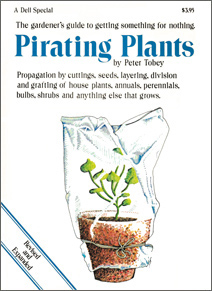|
||
|
|||||
TOBEY PUBLISHING Consumer book and magazine publisher with a wide variety of content. MUSTARDSEED & MOONSHINE Coordinating a B2B website with a new catalog designed for dual purposes. BRODART BOOKS Adding life to an aging international book distributor. SALEM PRESS Sales and marketing enjoyed a complete re-design at a venerable reference publisher. MULLICA HILL GROUP Industrial-strength refrigeration. EVANGELINE An elegant, small French restaurant in Portland, Maine. ZMAGS Electronic marketing for an electronic marketer. ENCOREAGAIN Helping to rid the universe of death through improved reincarnation. |
The following is a portion of the book's chapter on division, a method of creating new plants from old ones. DIVISION Division, as I'm using it here at least, is a kind of catchall process that describes all sorts of asexual propagation. It differs from the others discussed in this book by being a mixture of them. That is, the grab bag of division techniques involves the skills and methods found in most other kinds of propagation. But division is almost never as extreme a form. You don't divide something unless the part you end up with has some amount of root and above-ground growth. But the techniques involved in root cuttings and stem cuttings are essential to division. So, too, is an appreciation of the trauma of being torn apart. As a result, just about every sympathy you develop in other propagation methods is part of your job in division. But not to such a thorough degree. And, in a way, that brings us back to transplanting. In division you transplant part of a plant, each part having at least some roots and, if not fully-formed foliage, at least the buds to produce it. Having all the elements of a complete plant, a divided piece is in a much better position that a single part that is asked to differentiate beyond itself. All the makings of a plant are there, all you need to do is protect and encourage them. And this is probably the only hard-and-fast distinction between division and every other propagation method: you have to be careful to include both roots and buds in the divided part you intend to grow. The skill involved in doing so is a matter of recognizing divisible units within a plant. There are those plants that quite naturally 'divide' in the sense of producing clusters within themselves that can be easily broken apart. It is these that usually are treated with this technique. Their growth suggests division and, since it's easier, you should prefer it to cuttings, layering or some other method. In dividing anything, you have to remember that the plant depends on the good condition of its roots to survive. Separating roots that are tangled and grown together should be done gently. Breaking a few doesn't kill most divided bits, but it slows them. Similarly, if the top growth of the plant is tangled and difficult to separate, remember to try to leave each of the divided root structures with a small but complete set of foliage parts. If you keep that in mind and go slowly, you'll be able to find what's needed for the generation of a new plant and separate it from the whole. Generally, plants are divided when dormant. That makes sense in light of the appreciable shock that chopping up a living thing involves. Dormant division in the fall or very early spring allows the plant to set roots and establish top growth in accordance with its root supply. As in transplanting, this period of dormancy provides a lull in the demands the plant is making on itself and so allows it to concentrate its first energies on growing those parts it needs to survive. |
HORTICULTURAL NONFICTION Prose that appeals to mildly sentimental tastes. DIRECT RESPONSE MARKETING Getting librarians to pay attention. OFF-THE-WALL HUMOR Absurd, arching hyperbole. CATALOG COPY A professional sample. COOKBOOK PROSE Everyone loves chocolate chip cookies. A GARDENER'S THOUGHTS House plant whimsy. To return to the Writing Samples home page, click the pen image below: 
|
|||||||
|
ABOUT FUSE & COMPANY |
| © 2017 Fuse & Company. All Rights Reserved. |
